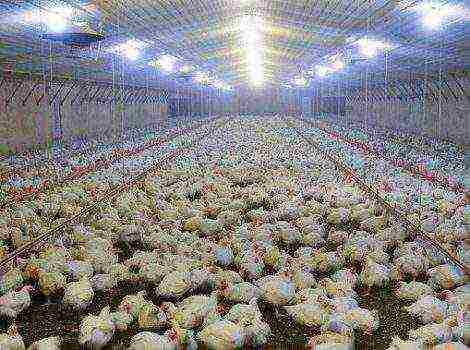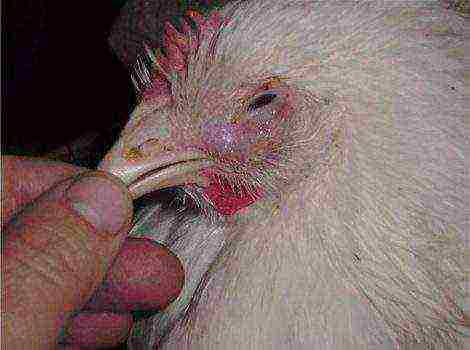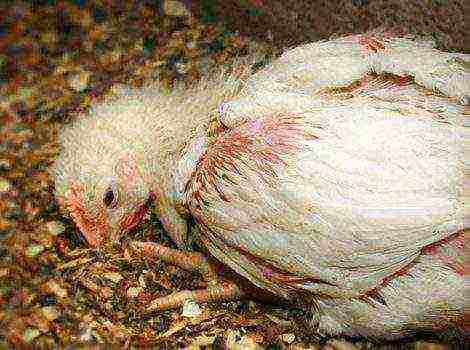Content
- 1 How to raise broilers at home
How to raise broilers at home
Broiler is a hybrid of domestic animals, obtained by crossing different breeds. It is distinguished by its early maturity. Broilers are called not only poultry, but also other animals, such as rabbits.
In this article we will talk about broiler chicken, namely: where to start, how to choose eggs, what and how to feed according to growth periods, how to water, what vitamins to give, what should not be fed, diseases and what to treat. Let's talk about adult broilers: living conditions, feeding and water, diseases and how to treat them.
In general, we will go through all the stages of cultivation - from eggs to the sale of the finished product.
How to choose eggs to grow
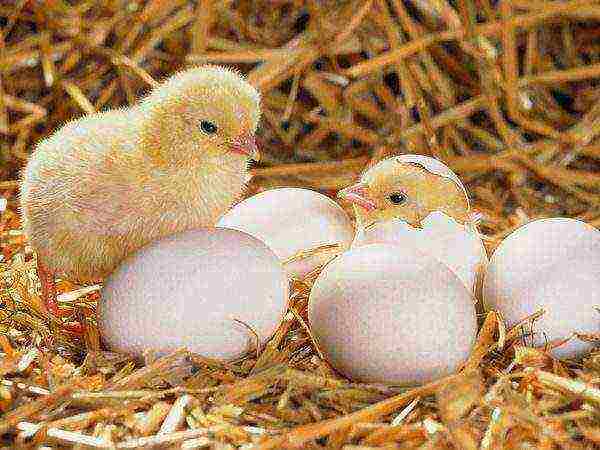
The choice of eggs for incubation is an important part of the broiler raising process, because it determines the percentage of chicks hatching, how healthy the offspring will turn out, how often they will get sick or not at all, how quickly they will gain weight, etc. Whether you will be left at a profit or at a loss will also depend on the right choice for laying the eggs.
The egg should be uniform in color. It is advisable to choose medium sizes, because the same offspring is obtained from small eggs.
Large ones have a thin shell. Therefore, the appearance of microscopic cracks, through which they penetrate into the embryo of infection, is not excluded. In addition, many eggs of this size simply will not hatch.
The weight of the egg is also selected, if possible, the same. Then the chicks are born with a slight difference in time.
We take eggs from the nests several times a day. Their overheating or cooling is unacceptable. It is advisable to store them in a warm, dry room, in which the permissible temperature drops do not exceed 5 degrees.

The maximum shelf life between removal from the nest and setting in the incubator is two or three days. If this period is exceeded, the likelihood of negative consequences for their healthy development in the future increases.
A correct, competent approach to the process of choosing eggs for laying them in an incubator is the key to a successful result.
The maximum age of a hen from which eggs are taken for an incubator is limited to 2 years.
What and how to feed
It is very important to feed broiler chicks correctly, starting from the first day of their life, because starting feeding sets the appropriate rate of growth and development of these poultry. In addition, the composition of the feed plays a decisive role in the quality of the final product - meat.
Broiler chicks from zero days
There is a widespread opinion that day-old broiler chickens should be immediately given chopped boiled eggs, cottage cheese, mixed feed, which help to strengthen the digestive system.
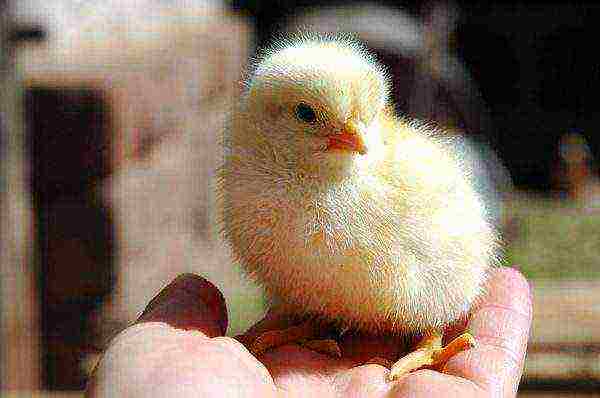
However, others caution against such a decision. They argue that this is precisely the reason for the death of the poultry population during the first 2 - 3 days of their life. And feeding broiler chickens with boiled eggs at one day of age not only does not strengthen their immunity, but also causes a disorder of the digestive system, causes a large number of deaths.
It is not recommended to give any wet food. It is useful at such an early age to give only millet and a small amount of egg powder. Chicks should have free access to feed and water. The size of the cage, box, and other place in which the brood was kept allowed each chicken to eat and drink freely. In water, we dilute potassium permanganate (potassium permanganate) in a very low concentration.
In this case, the color of the water should not be allowed to change to pink. It is also recommended to separately prepare an aqueous glucose solution. This will help avoid indigestion - a disease of the digestive tract.
Weekly chicks
You can gradually accustom kids to starting compound feed from the fifth day of their life. At the same time, they are soldered with a prominent solution of vitamins. Before this age, it is not recommended to give them antibiotics.
It is useful to drop "Trivitamin" into the beak of each chicken - a drug for the treatment and prevention of vitamin deficiency. Add "Baytril" to the water, which is intended against infections at the rate of 1 gram per 2 liters of water.
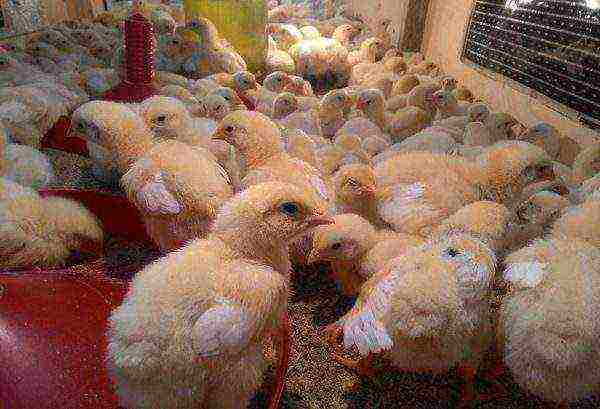
From one week of age, chickens are taught to eat cottage cheese. We vary the diet with crushed boiled egg. The feed can be slightly moistened with whey. The approximate daily consumption rate during this period reaches 15 - 20 grams. Indoor temperature - 30 - 32 degrees.
Important! Make sure the chickens do not get dirty or wet while eating. Otherwise, it is fraught with their death. The places where they are kept must be dry with the required temperature and humidity.
Chickens from 10 to 20 days
During this period, greens are added to the porridge (slightly moistened dry starter food), for example, finely chopped onions, at the rate of 1:20. It contains the necessary vitamins. Besides, green onions are used as an antiparasitic agent.
To avoid one of the most common diseases of poultry - coccidosis, which leads to disruption of digestion and dehydration of the body, at two weeks of age, add the drug Baycox to the water at the rate of 1 gram per 2 liters of water.
During this period, they eat feed up to 30 grams per day. In order for babies to have a good growth, take care of an increased daylight from the first days. The ambient temperature is kept at a level not lower than 28 degrees. If young animals at this age are overcooled, they can get bronchopneumonia, which occurs precisely as a result of hypothermia.
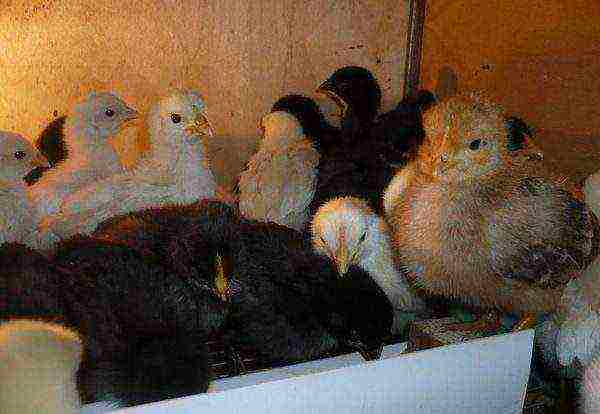
You can add reverse, yogurt, buttermilk to the feed. After 15 days of feeding, protein feed of plant origin is mixed into the food. The proportion of greenery can be gradually increased. It should now account for up to 10% of the total feed weight.
Stir in crushed eggshells, feed yeast, and grated carrots in small amounts. In no case should sand be given to chickens. Do not forget to make a very weak solution of potassium permanganate.
From day 10 for three or four days, broilers may begin to die. Therefore, during this period, we solder poultry with antibiotics. Add a couple of drops of iodine. After a short break, vitamins are given, vitamin D is especially important during this period for rickets.
Lack of vitamins leads to hypovitaminosis A, D, E, B. Chickens are given only high-quality feed. If you buy it ready-made in a package, keep an eye on the expiration dates.
How to raise monthly chicks
After 22-25 days, they switch from feeding with starting compound feed (cereals) to growing (in granules). The composition of the broiler feed should include mineral content, protein (fish meal), cereals (corn), amino acids and vitamins.The green mass can also be continued to be added.
To save money we advise do not buy expensive growth food, but make its composition yourself: crushed wheat, oats, corn, barley, peas. All components are mixed in equal proportions. It is advisable to add fish oil, whey, meat and bone meal to the feed. Add (but do not mix) the leaves of cabbage, lettuce, green onions.
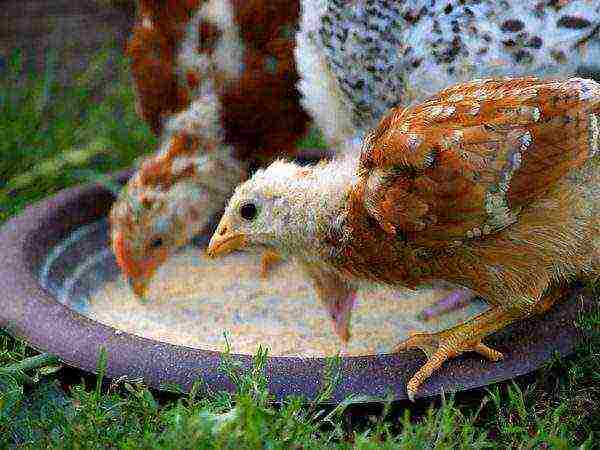
By 35 days of age, you can gradually increase the amount of corn to 40% of the total, and reduce the amount of wheat, oats and barley. The meal or cake is about 15%. The percentage of green mass can be reduced.
Under normal conditions and quality feeding, monthly chicks weigh about 800 grams.
We exclude from the diet all types of bread, boiled potatoes (if it does not go in a mixture with other components), all stitched products, especially if you smell. We remind you to refrain from adding sand. We make sure that the water of the chickens is constantly clean, fresh, slightly warm. It is useful to use settled water.
We lower the temperature of the medium to 23 - 25 degrees. The duration of lighting is reduced to 14-16 hours a day.
To avoid aspergillosis at this age, you need to ventilate the room well, avoid dampness. For prophylaxis, add a little iodine-containing preparations to feed and water.
Chickens 45-50 days
After 40 days of life, the young are given not crushed, but whole grain. A commercially available finishing compound feed containing the main nutrients is also used. But if you want to have tasty meat, you can refuse to purchase it.
Whole grain is poured into the feeders, not crushed grain. Vitamins, feed yeast, chalk must also be present in the feed. After reaching 45 days of age, we exclude any medications. A good effect is given by cooking porridge, which includes boiled small fish, corn, wheat, peas, greens.

All this is mixed and allowed to brew. In porridge, we increase the percentage of corn to half of the total mass.
If you did not save on feed and gave a complete diet, their weight at this age should be more than one kilogram. The breed also has a big influence on this figure.
If the weight of a unit of young of one breed reaches 1, 2 - 1.3 kg, then the weight of a grown chick of this age can be 1.6 - 1.8 kg. all other things being equal.
We continue to use clean settled water. We gradually lower the ambient temperature to 21 - 23 degrees. The duration of daily lighting is reduced to 12-14 hours.
Breeding adult broilers at home
Keeping broilers for fattening for more than two months is not economically feasible, as the birds gain weight more slowly with age and feed more. In addition, broiler meat older than 70-75 days is less tasty than two months old.
Cell maintenance and care at home
If you want to raise up to 10 head of chicken broilers at home, their cage content will suit you. Depending on the size of the cage, they contain 3-5 heads (then the size of the cage is made from such a calculation in order to limit the free movement of the bird to the required one - to go to the feeder and drinker), or up to 10 heads (the size of the cage increases, the requirements for the spatial conditions of detention and the dilutions remain the same).
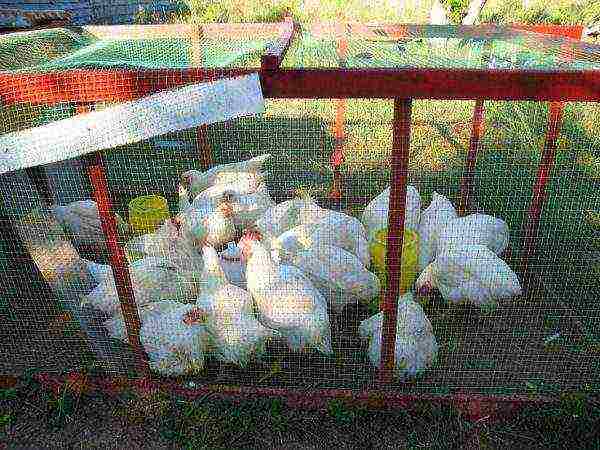
When growing livestock more than 10 units need to do or additional number of cells (since one cage, with more than a dozen heads in it, is very cumbersome and inconvenient to move, it loses mobility), or think about keeping in a pen.
Let's say that it is economically beneficial for you to breed livestock in cages. Then, for dry food (mixed fodder, grain), it is advisable to choose trough-type feeders, which are placed outside the cages along a whole tier. We also build a continuous drinking bowl, for example, from a PVC sewer pipe.
The front side of the trough can be made from metal rods of the combined type. This is convenient because chickens can be kept in such a cage at first.
Steel rods on the walls are placed among themselves quite often so that the brood does not run out of the cage or fall out of it (if the cage is in the second or third tier).
After the young grows up, they are seated in different cages, removing the rods from the walls through one. Thus, we provide free access to feed for an adult broiler.
How to grow: tips for beginners
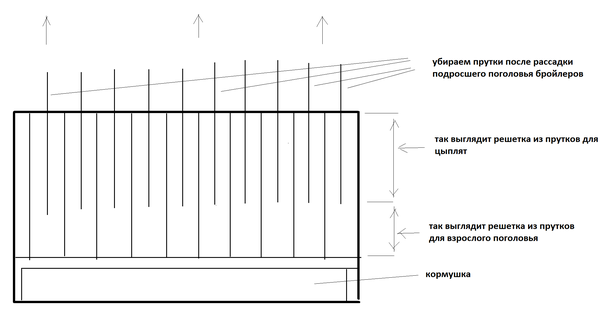
There are several requirements for the conditions of keeping an adult broiler bird:
- so that the content area makes it possible eat freely each individual, that is, not too small, but not too large (the reasons are indicated above);
- permanent availability of high-quality fresh feed in the feeders. In addition, there can and should be separate feeders for porridge, if used;
- constant availability of fresh (better settled) warm water in drinking bowls, but not higher than 22-25 degrees;
- enough hours daylight hours (12-14 hours). If less - we give additional lighting;
- humidity air 68-72%;
- no dampnessespecially in cells;
- no drafts must not be;
- ambient temperature - within 20-21 degrees (if it is lower, then the activity of broilers decreases, the intensity of feed consumption decreases, the growth of mass slows down; if it is higher, then the bird becomes hot, the result is the same);
- obligatory presence ventilation, since otherwise the intensive accumulation of nitrogen has a detrimental effect on the vital activity of the bird. A case is described when the owner, in order to save on heating, placed the floor of a hundred broilers in a greenhouse where greens were grown in a small makeshift paddock. Despite the fact that the greenhouse was periodically supplied with fresh air, after a few days the greens began to fade due to the increased nitrogen content in the air, although this was not felt. After the corral was fenced off with foil, the concentration of nitrogen in the environment in the corral reached such a level that the chickens began to behave sluggishly, ate feed reluctantly, and slowly gained weight.
- cells inside must be clean... To do this, you can make the floor from a galvanized welded fine mesh, and clean the floor pallet based on the amount of droppings accumulated in it;
- if growing broilers at home is "put" on stream, then it is necessary to periodically carry out disinfection of cells (after the slaughter of the previous batch, but before growing the second).
Disadvantages of keeping birds in cages:
- requires monetary investments more than with a driven cultivation method.
Advantages:
- more convenient in service;
- more compact (saves used space).
How to keep and raise a broiler in a pen
This method of keeping broilers and chickens from zero days does not differ from the previous one. The main differences are as follows:
- economically viable in terms of construction. Basically, to raise birds in a pen you need a floor and walls. If you are going to raise a bird in a barn, then part of the barn is fenced off with collapsible sections made of welded mesh wire, put feeders and drinkers - and the pen is ready;
- designed for content not less than 10 heads birds;
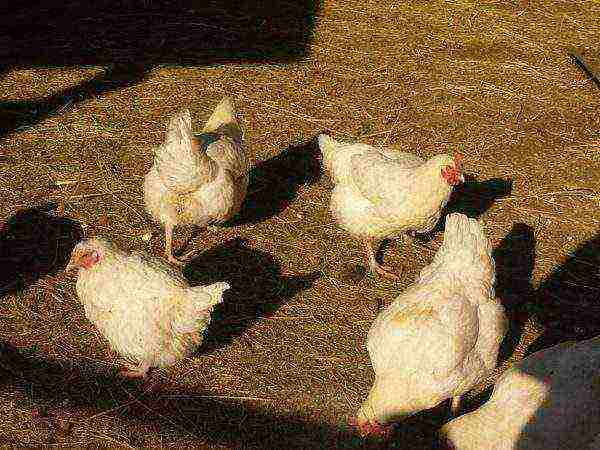
Flaws:
- requires increased care and attention to elimination of dampness and high humidity, you need to frequently change the litter of broilers to keep the floor dry;
- by area occupies more space per one livestock unit.
Advantages:
- less material costs, compared to the first method.
Requirements for ambient temperature, humidity, absence of drafts, dampness and other conditions of detention remain the same.
Correct feeding. Where to begin
As mentioned above, it makes no sense to fatten broilers for more than two months. This is justified by the following:
- after two months fattening poultry gains weight more slowly;
- consumption feed increases;
- broiler meat older than 2.5 months tougherless tasty.
Feeding adult broilers (in our case, in the recommended age range from 60 to 75 days) comes down to the fact that they need to be given only high-quality feed with the following diet:
But even more worries will be added, in order to breed chickens, you will need to buy separately grain of wheat, barley, corn, peas, etc., mix all this in proportions. Do not forget to give greens, add fishmeal.
If you are not lazy, then prepare porridge for your poultry from the above ingredients with the addition of cooked small fish. If there is no fish, add fish oil. The main specific gravity should be maize (up to 50%).
Some, when growing poultry, after two months of feeding, switch exclusively to corn and greens (5-10 days before slaughter). For normal chain feeding, expect your broilers to weigh at least two kilograms by 70 to 75 days of feeding.
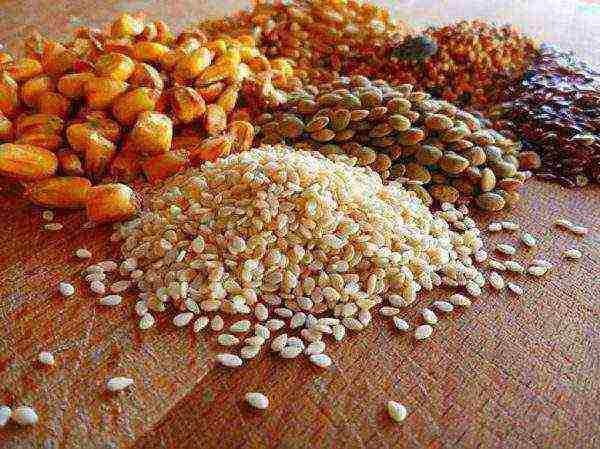
Attention! We do not give broilers:
- boiled potato (if it does not go in a mixture with other components);
- all varieties of bread;
- all overdue products;
- sand;
- medications (if possible);
- several new products food in large quantities;
- other components, if we see that they call negative reaction the bird.
What to drink
Follow the same rules as for raising young stock. The water should be:
- clean, preferably separated;
- moderately warm (in the region of 20 - 21 degrees);
- in drinking bowls, providing unimpeded access poultry (depends on the number of livestock);
- can be diluted at very low concentrations potassium permanganate (potassium permanganate). In this case, the color of the water must not be allowed to change to pink.
Broiler chicken diseases
Broiler chickens can be sick with quite a few diseases. Some of them:
- heterokydosis - worms in the intestines. Piperazine can be used against this disease. Preventive measures - thoroughly wash the room in which the chickens are;
- arthritis - joints of chickens suffer (broilers walk less, try to sit down). Ampicillin (10 mg per 5 kg chicken weight) can be used for 5 consecutive days.

Ampicillin for arthritis Arthritis prevention measures: Provide only quality food, bedding should be dry;
- ascites (accumulates fat in the abdomen). The bird walks sluggishly and reluctantly. To avoid this disease, it is necessary to give greens;
- salmonellosis manifests itself in upset stomach... Can be treated with tetracycline or dithrevite. The dosage is indicated in the instructions for these medicinal products;
- pseudo-plague - chickens can become infected through contaminated eggshells. It is necessary to plant the sick and disinfect the room;
- simple poisoning... To avoid this, you need to ensure that the food is fresh and of high quality, and that foreign objects, such as fish bones, do not fall into the feeders).
If you do everything right, the result will not be long in coming.
Recommendation for beginners: there is nothing better than personal experience... Therefore, in the initial stages of your business development, you can use the information and recommendations of others. But if in practice you achieve the best results thanks to your best practices, it is a sin not to take advantage of this.
If you find that some recommendation does not apply to the growing conditions of broiler chickens in your conditions, think for yourself how to get out of the situation to achieve optimal results.
